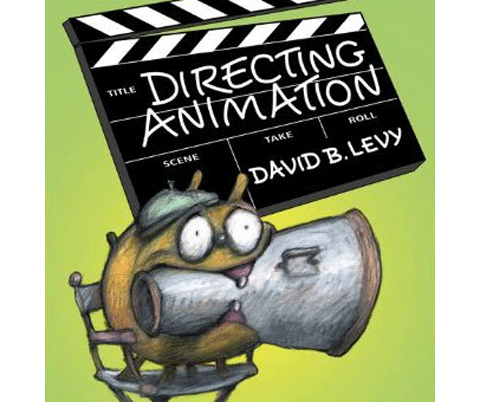

BOOK EXCERPT: “Directing Animation”

New York animation director and ASIFA-East president David Levy has written a trio of helpful books aimed at young artists entering the industry. First, there was the general overview Your Career in Animation: How to Survive and Thrive followed by Animation Development: From Pitch to Production
. Most recently, he authored Directing Animation
. All three books offer the kind of nuts-and-bolts advice that is often hard to come by for inexperienced artists.
In this exclusive excerpt from Directing Animation, Dave describes a particularly bad experience working with a director, and the importance of maintaining open lines of communication between the director and the crew.
The Closed-Door Director
by David Levy
 According to Nickelodeon’s Making Fiends creator and director Amy Winfrey, one advantage to having in-house animators is that the director can talk directly to the animator. “It is much easier to get exactly what you want from a shot if you are able to communicate directly with the animators,” she says. That may seem like common sense, but there are plenty of stories of animation directors squandering the opportunity to collaborate with an in-house crew. In contrast, Winfrey works closely with her entire staff, encouraging the storyboard artists and animatic editors to suggest changes and gags, which can make the finished episode much stronger. The animation director of an in-house production has the chance to bring the whole crew together. On Making Fiends, Winfrey says, “We always showed the first pass of the animatic to the whole crew. It was wonderful to see the work of the writers, storyboard artists, and voice actors come together. It’s always satisfying to hear people laugh!”
According to Nickelodeon’s Making Fiends creator and director Amy Winfrey, one advantage to having in-house animators is that the director can talk directly to the animator. “It is much easier to get exactly what you want from a shot if you are able to communicate directly with the animators,” she says. That may seem like common sense, but there are plenty of stories of animation directors squandering the opportunity to collaborate with an in-house crew. In contrast, Winfrey works closely with her entire staff, encouraging the storyboard artists and animatic editors to suggest changes and gags, which can make the finished episode much stronger. The animation director of an in-house production has the chance to bring the whole crew together. On Making Fiends, Winfrey says, “We always showed the first pass of the animatic to the whole crew. It was wonderful to see the work of the writers, storyboard artists, and voice actors come together. It’s always satisfying to hear people laugh!”
If Winfrey provides a best-case scenario, a recent job animating on a pilot provided my worst experience to date. And in the same way that it’s useful to examine what makes good direction so effective and inspiring, analyzing the opposite extreme can help bring into focus the pitfalls of directing and how they can be avoided.
In all fairness, sometimes great facility as an artist or animator can be why a person gained the opportunity to direct. But talent in one area does not automatically translate to another. Having the skills to manage, lead, inspire, and direct others is quite different. The average animation artist wears many hats over a typical career, and for those who direct, it’s helpful to have been directed. This will give important insight into the process of how work is assigned/reviewed, how notes are given, how workflow/deadlines are managed, and how it feels to be directed. Remember what you liked and didn’t like when you were directed. What style of organization made things run smoothly and what caused problems? As a director you’ll have a lot of influence you can use to create a winning production pipeline or help fine-tune an existing system that could run even better.
Once you have worked as a director you will still likely work again in other areas on subsequent jobs, maybe as a storyboard artist, animator, or designer. After working exclusively as a director for eight years in a row, I found myself working as an animator on a preschool pilot. Right away we animators knew the project was going to be challenging. First of all, many scenes were up to twenty seconds long and usually featured four characters that we had to keep alive and interacting. The pilot’s character files, animated in After Effects, were cumbersome, overly complex, and constantly crashing the computer, which slowed down workflow. Full character rotations were built for each character when a half rotation would have sufficed and been a lot more efficient. All of this was because of the director’s desire to use “full animation” in a tight TV animation budget and schedule. After Effects can certainly work wonders to help shave off some work hours, but it can’t work miracles. The miracle was expected to come from the animators.
Added to this was a director who sequestered herself in her closed-door office, not fully committing to her responsibilities on this pilot. Since the in-house crew of animators didn’t have access to her, she insisted we all log on to Instant Messenger so she could answer any questions or send us direction. It was a very sad waste of our proximity. In fact, the only time I would see her at my desk was when an artist from another production would (briefly) stop by to say hello to me, which would cause my director to suddenly appear to shoo the visitor away. Ah, there’s nothing like working in a trusting environment–and this was nothing like working in one. Outside of those times, the director remained mostly shuttered away, on the phone, and unavailable.
Robert Renzetti, veteran animation director and creator of Nickelodeon/ Frederator’s My Life as a Teenage Robot, explains that if you are strictly doing timing (on exposure sheets), you can hide in your room all day if you like and talk to no one. But, he warns, “This would not bode well for your future employment. The more you are involved with other aspects of the production process the more people skills you will need.” And to that I would add, the more direct contact with people you should have.
The first thing I noticed when I started on this job was that all the scene numbers and tracking numbers of all art and assets didn’t match to the storyboard/animatic numbers. So, when you got a scene assignment, you weren’t sure which was the correct scene to animate. As we worked we found that we couldn’t rely on the storyboard/animatic as the final word for scene cuts or blocking. The creators, producers, and directors kept changing their minds.
For the first month, no deadline targets were assigned for any scene. The production was that loose! Finally, once it became clear that the pilot was going to go over schedule, the senior staff had a meeting and decided to implement a daily footage quota on the animators. From this point forward, each animator was expected to deliver a minimum of eight seconds of finished animation per day. This wasn’t so impossible, unless you factored in that each scene likely held four characters. This could significantly impact the ability to deliver eight seconds a day because four characters could mean four times as much work. But, since the director and the production didn’t acknowledge the reality in their quota, it was a real morale-killer.
As the pilot neared completion, the strain on the budget increased and we went weeks over schedule. The director showed signs of stress that came out as she unprofessionally griped about the work of one animator to another. I’ll never forget one particular day on the pilot when I was animating a four-character scene that was eighteen seconds long. At the end of the day I had two of the characters fully animated all the way up to eighteen seconds. I put on my coat to call it a night, but the director stopped me before I could leave.
“Did you finish your scene?” she asked. “No,” I answered. “I just started this one today . . . but I did get two of the characters animated all the way through.” She replied, “So, it’s not finished? You’re going to deliver the shot late?” “What is late?” I asked. “I animated two characters all the way through to 18 seconds. Based on the eight-seconds-a day-quota, I more than doubled the expectation. So it was a good work day with a lot accomplished.”
“Well, it would have been great if it could have been done today,” she insisted. Realizing I was talking to a wall, I smiled and shrugged my shoulders. Then she shrugged her shoulders back to me and concluded with, “I’m just saying.”
I truly have had a charmed work life, because this two-month job was the worst working experience of my thirteen-year career. It also demonstrates the importance of a strong director who understands every aspect of the job. Earlier, I stressed that it’s important for a director to have worked in other animation positions prior to directing. This director met those requirements, having worked for years in the industry in various capacities, and was a talented and accomplished artist to boot.
The problem was she didn’t utilize her knowledge of process, schedule, deadlines, and what it feels like to be directed to help build a workable production. A key to learning or self-development is the ability to have some degree of introspection. You have to be able to take responsibility for mistakes, to recognize your role in the problem, and to have the desire to not make those mistakes again.
The pilot (in this story) finally got finished and, due to the considerable extra time we spent (and despite the toll on the crew), it looked good. As for the director, the ball is in her court, and she may have learned about working with a staff of in-house animators and crew and what it takes to properly prep, assign, schedule, and direct their work.
Animation director Rob Renzetti knows the benefits of working with an in-house crew based on his experience on Cartoon Network’s Foster’s Home for Imaginary Friends, saying, “Almost all TV programming is actually animated overseas. The only exception for me has been Foster’s, which was animated in Flash at Cartoon Network Studios. Having the animators in-house (and speaking English) was an amazing luxury. I was able to preview scenes before they were complete, make adjustments before we would get to the official retake session, and when we did call retakes I could just walk over to the retake supervisor if there was any confusion or something too complicated to explain in a retake note. It was heaven.”
Helping sum up the importance of the director position, veteran Web animation director Xeth Feinberg (Queer Duck, Hard Drinkin’ Lincoln), says that a strong animation director will have the ability to:
• inspire
• explain
• organize a project and prioritize tasks
• work with others by setting understandable goals
• assess workers and make the best use their individual skills
• listen to others without losing one’s own sense of judgment
David Levy’s book Directing Animation can be purchased on on Amazon for $16.47.
(David Levy photo credit: Michael Sporn)

